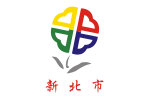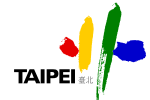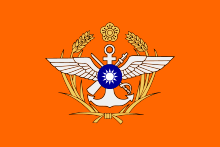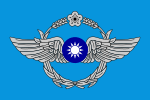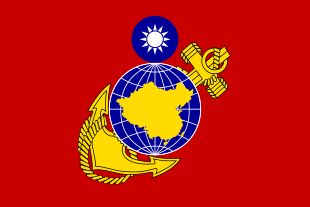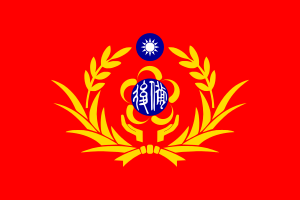Flag of the Republic of China
The flag of the Republic of China (also known as the Blue Sky, White Sun, and a Wholly Red Earth and the flag of Taiwan) consists of a red field with a blue canton bearing a white disc with twelve triangles surrounding it. The disc and triangles symbolize the sun and rays of light emanating from it respectively.
 | |
| Name | 青天白日滿地紅 , literally "Blue Sky, White Sun, and a Wholly Red Earth" |
|---|---|
| Use | Civil and state flag, national ensign |
| Proportion | 2:3 |
| Adopted | 1894 (by Revive China Society, original version) 1906 (addition of the red field) 1 January 1912 (naval flag) 5 May 1921 (by Guangzhou government) 9 December 1928 (in mainland China) 25 October 1945 (in Taiwan) |
| Design | A red field with a navy blue canton bearing a white sun with 12 triangular rays. |
| Designed by | Lu Haodong and Sun Yat-sen |
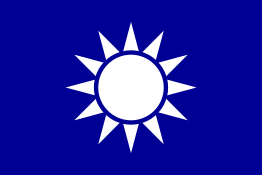 Naval Jack | |
| Name | "Blue Sky with a White Sun" flag (青天白日旗) Republic of China naval jack. |
| Use | Naval Jack |
| Proportion | 2:3 |
| Adopted | 1895 |
| Design | A white Sun with twelve rays on a navy blue background. |
| Designed by | Lu Haodong |
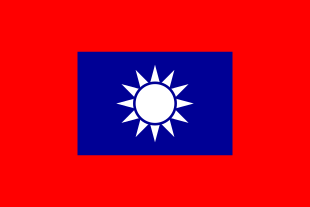 Army flag | |
| Use | War flag |
| Proportion | 2:3 |
| Design | A red field with a navy blue rectangular center with a white sun with twelve rays on top of the blue. |
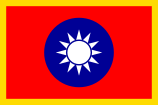 Presidential standard flag | |
| Use | Presidential standard |
| Proportion | 2:3 |
| Design | A red field with a yellow border and navy blue circle on the top, a white sun with twelve rays is on top of the blue. |
| Flag of the Republic of China | |||||||
|---|---|---|---|---|---|---|---|
| Traditional Chinese | 中華民國國旗 | ||||||
| Simplified Chinese | 中华民国国旗 | ||||||
| Literal meaning | Republic of China flag | ||||||
| |||||||
| Blue Sky, White Sun and a Wholly Red Earth | |||||||
| Traditional Chinese | 青天白日滿地紅 | ||||||
| Simplified Chinese | 青天白日满地红 | ||||||
| Literal meaning | Blue sky, white sun, wholly red earth | ||||||
| |||||||
The flag was originally designed by the anti-Qing group, Revive China Society in 1894 with the addition of the red field component in 1906 by Dr. Sun Yat-sen in speech.
It was first used in mainland China as the Navy flag in 1912,[1] and was made the official national flag of the Republic of China (ROC) in 1928 by the Kuomintang (KMT). It was enshrined in the sixth article of the Constitution of the Republic of China when it was promulgated in 1947. The flag is no longer officially used in mainland China, as the People's Republic of China was founded in 1949.
As the islands of Taiwan and Penghu were under Japanese rule until 1945, the flag was not in use in two territories, until the ROC took control in 1945. The flag is now mostly used within Taiwan, Penghu, Kinmen, Matsu and other outlying islands, where the ROC relocated in 1949 after its defeat in the Chinese Civil War.
History

The first national flag of Taiwan was first used in 1663 during the Kingdom of Tungning which had a plain white flag with the character "鄭" (zhèng) on the red bordered circle. The flag of the Qing dynasty was also used from 1683 until 1895 when the Republic of Formosa was declared. The Formosan flag had a tiger on a plain blue filed with azure clouds below it.
During Japanese rule of Taiwan, the flag of Japan was flown in the island from 1895 to 1945. At the same time, when the government of the Republic of China was established on 1 January 1912, the "Five-Colored Flag" was selected by the provisional Senate as the national flag. The "18-Star Flag" was adopted by the army[2] and the modern flag was adopted as a naval ensign. Sun Yat-sen, however, did not consider the five-colored flag appropriate, reasoning that horizontal order implied a hierarchy or class like that which existed during dynastic times.
Following the transfer of Taiwan from Japan to China in 1945, the flag was specified in Article Six of the 1947 Constitution. After the Chinese Civil War in 1949, the government of Chiang Kai-shek relocated the Republic of China (ROC) to the island of Taiwan. On the mainland, the communist forces of Mao Zedong established the People's Republic of China and adopted their own national flag. On 23 October 1954, the National Emblem and National Flag of the Republic of China Act (中華民國國徽國旗法; Zhōnghuá Mínguó guóhuī guóqífǎ) was promulgated by the Legislative Yuan to specify the size, measure, ratio, production, and management of the flag.[4]
Ban in Cambodia
While public display of the ROC flag is generally frowned upon, and may even lead to arrest in the PRC, Cambodia was the first country to outlaw it officially. In February 2017, Prime Minister Hun Sen announced that the ROC flag will be banned from being displayed in Cambodia as a part of its commitment to the One-China policy.[5][6]
Symbolism
In the "Blue Sky with a White Sun" flag of Lu Hao-tung, unveiled in 1895 in Hawaii. The twelve rays of the white Sun symbolize the twelve months and the twelve traditional shichen (時辰; shíchén), a traditional unit of time which corresponds to two modern hours. Sun Yat-sen added the "Red Earth" to the flag to signify the blood of the revolutionaries who sacrificed themselves in order to overthrow the Qing Dynasty and create the ROC. Together, the three colors of the flag correspond to the Three Principles of the People: Blue represents nationalism and liberty; White represents democracy and equality; and Red represents the people's livelihood and fraternity.[7] President Chiang Kai-shek proclaimed on the National Day in 1929, "As long as a national flag with Blue Sky, White Sun, and a Wholly Red Earth flies on the land of China, it symbolises the independence and liberty of the descendants of the Huang Emperor".
The blue-and-white canton of the ROC flag is often used as the party flag of the KMT. The flag has developed a great deal of additional symbolism due to the unique and controversial political status of Taiwan. At one level, the flag represents a clear symbol that Taiwan is not governed by the same government as Mainland China, as this flag is different from the flag of the People's Republic of China (PRC).
Meanwhile, because it was formerly used as the flag over all of China, the flag has become a symbol of continuity with the ideals of the Chinese nationalism and Chinese reunification movements, and has become a symbol of a connection both historical and current with mainland China. In addition, the flag is derived from the seal of the KMT, and the color of the field of the flag is associated with the KMT party colors.
Some Chinese see the flag as an expression of Chinese nationalism and pride combined with simultaneous disapproval for the current communist regime. Additionally, the flag may symbolize identification with, and admiration for the political thoughts of Sun Yat-sen, and his Three Principles of the People.
One irony is that given the association of the flag with Chinese nationalism in opposition to Taiwan independence, the ROC flag has found an unexpected ally in the People's Republic of China. The PRC has criticized Taiwan independence groups for wishing to change or abolish the ROC flag, and has implied that legal steps to do so would bring a strongly negative reaction from the PRC.
However, the presence of the ROC flag in Taiwan also distinguishes the fact that Taiwan and ROC territorial islands elsewhere fall under jurisdiction of a country separate from that of mainland China, the People's Republic of China (PRC). The hoisting of the ROC flag is even advocated by the most extreme Taiwanese independence supporters, such as Taiwan Solidarity Union members when emphasizing the separate and independently governed systems and territories of the Republic of China and the People's Republic of China in mainland China.
Construction details
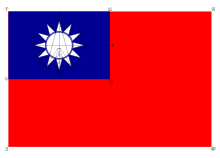
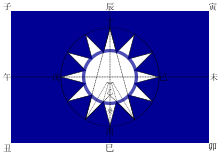
_sheet.svg.png)
The specific designs of the flag are located in the "Law about the national flag and emblem of the Republic of China." The ratio of the flag is 2:3, with most of it being red. One-fourth of the flag is blue, which contains the 12 pointed sun. Each sun ray is 30 degrees, so the total sun rays will make up a complete 360 degree circle. Inside the sun, the blue ring is the diameter of the white sun divided by 15.[8]
In later years, more specifics of the canton area (also used as the flag of the KMT), were codified into law. In the drawing released in "Law on the Party and National Flag Manufacturing and Methods" (黨旗國旗之製造及使用辦法), the sun was drawn in more specific detail and mathematical values were given to all elements in the flag. In the law, the canton still had a ratio of 2:3, but the math values given were 24x36 meters. The diameter of the sun with rays is 6⁄8 of height of the canton, so in this case, it will be 18. The diameter of the white sun without the sun rays is 1⁄4 of the width of the canton, so it is 9. The blue ring that is on top of this sun and part of the rays is 1⁄15 diameter of the white sun, so the size will be 0.6. The angle of the rays, 30 degrees, and the total number of rays have not changed.[9]
The colors of the national flag are dark red, white and dark blue. The KMT party flag just uses white and dark blue and both flags are to be topped with a golden finial.[10] The law does not list any specific color processes, such as Pantone, to manufacturing or drawing the flag. Other publications, such as the Album des pavillons nationaux et des marques distinctives, have given approximations for Pantone colors. The dark blue color is Pantone 301c and the dark red is Pantone 186c.[11] Album des pavillons also gave the approximate CMYK colors for the flag; dark blue is 100-45-0-10 and dark red is 0-90-75-5.[11]
Colours
The colors approximation in other color spaces are listed below:
Colours scheme | Blue | Red | White |
|---|---|---|---|
| RGB | 0-0-149 | 254-0-0 | 255-255-255 |
| Hexadecimal | #000095 | #FE0000 | #FFFFFF |
| CMYK | 100, 100, 0, 42 | 0, 100, 100, 0 | 0, 0, 0, 0 |
Uses
In the early years of the Republic, under the KMT's political tutelage, the flag shared the same prominence as the KMT party flag. A common wall display consisted of the KMT flag perched on the left and the ROC flag perched on the right, each tilted at an angle with a portrait of Father of the Nation Sun Yat-sen displayed in the center. For the summits held between the KMT and Communist Party during the Chinese Civil War, the ROC flag was displayed at an equal position to the flag of the Chinese Soviet Republic (Jiangxi Soviet). Later, the flag law specified a horizontal display of the flag with the portrait of Sun Yat-sen in a portion of the red field at the center position. This display can be found in numerous government offices in Taiwan and is that which the President and Vice President face to take the oath of office.
The flag has a ubiquitous presence in Taiwan. The hoisting and lowering of the flag are ceremoniously accompanied by the National Banner Song while those present stand at attention to give a standard salute with the right hand, held flat, to the right eyebrow. Schoolchildren have traditionally been required to attend morning rallies where the flag is raised after a rendition of the National Anthem of the Republic of China. Before martial law was lifted in 1987 in Taiwan, it was required that all vehicles be halted when passing by a flag ceremony.
The ROC flag is not commonly seen at international gatherings in which the PRC participates due to pressure from the PRC over the political status of Taiwan and resulting minimal political influence of the ROC in such circles. Instead, the ROC is usually represented under a pseudonym (usually "Chinese Taipei") and in the case of Olympics, it flies its own flag, the Chinese Taipei flag. This is because the IOC recognises the PRC's position that the ROC is a defunct entity and that the ROC on Taiwan is illegitimate. The ban also effectively applies to spectators—during a Table Tennis final match at the 1996 Atlanta Olympics, police arrested a Taiwanese student for waving the ROC flag.[12]
However, the symbolism of the flag began to shift in the early 21st century as there was a warming of relations between the pan-Blue coalition in Taiwan and the Communist Party of China on mainland China. The flag of the Republic of China has begun to symbolize the existence of a past and possibly future unified China, and as such the government of the PRC has made it clear that for Taiwan to change the flag would be a major provocation in favor of Taiwan independence. The ambiguity surrounding the flag was made apparent during the trip of Kuomintang Chairman Lien Chan to mainland China in April 2005, during which the flag was very prominently displayed at ceremonies honoring Sun Yat-Sen at which both KMT party officials and government officials from the PRC were in attendance. One place in Mainland China where the White Sun emblem is still prominently displayed in public is the ceiling mosaic within Sun Yat-sen Mausoleum in Nanjing.
The use of the flag in Taiwan reflects the controversy behind its symbolism. Although supporters of Taiwan independence, such as former President Chen Shui-bian, will display and salute the flag on formal official state occasions, it is never seen at political rallies of the Democratic Progressive Party. This is not only because of its association with mainland China but also because the flag contains design elements of the KMT party flag. By contrast, the ROC flag is always extremely prominent at political rallies of the pan-Blue coalition. This difference extends to the colors seen at the rallies. Rallies of the pan-Blue coalition give prominence to the colors of the ROC flag, with very large amounts of blue and smaller amounts of red. Rallies of independence-leaning parties are filled with green, with no blue or red at all.
Some supporters of Taiwan independence, including former president Lee Teng-hui, have called for the abandonment of the flag, and there are a number of alternate designs for a specifically Taiwanese flag. However, the prospects for this are not high given that changing the flag requires a constitutional amendment; that the current flag has a huge amount of support among pan-Blue supporters and grudging acceptance among moderate independence supporters; and because changing the flag might cause political tension with the PRC. During the 2004 ROC legislative elections, it was briefly suggested that if the pan-green coalition won the elections that it would force the KMT to change the party emblem to be different from the flag. This proposal generated a few days of controversy and was then quickly forgotten.
Incidents
During a concert in Manchester in November 2013, singer Deserts Chang held on the flag of the ROC to the audience sparking protests from the PRC, which led to its cancellation of her concert in Beijing.[13]
Similarly, in November 2015, singer Chou Tzu-yu appeared with Twice on the South Korean variety show My Little Television. She introduced herself as Taiwanese and held the ROC flag alongside that of South Korea. The Japanese flag was also shown, representing the nationality of some of the band's other members.[14] Although it was widely condemned by the PRC, the ROC's Mainland Affairs Council (MAC) stated that it supported Chou's waving a Republic of China flag as a patriotic act. It lodged a protest with the mainland's Taiwan Affairs Office (TAO), urging the Chinese government to "restrain its private sector", which it said had "seriously hurt the feelings" of the Taiwanese people and might further damage Cross-Strait relations. It urged people on both sides of the strait "to cherish the hard-earned friendly ties".[15]
A local council in the Australian city of Rockhampton upset a Taiwanese Australian family after they painted over their children's hand painted depictions of the Taiwanese flag on a fibreglass bull statue which had been placed on the riverbank as part of the city's triennial Beef Australia celebrations.[16] The Taiwan-born siblings had painted two flags among the various Barramundi-shaped flags painted by students from North Rockhampton State High School.[17] The bull, placed in front of Customs House, was designed to symbolise the city's multicultural community but the two flags were later censored by being painted over.[17] Rockhampton Regional Council admitted they had done so in line with the Australian Government's One China policy.[17] However, there was speculation in the media that it was done to avoid offending Chinese delegates who were visiting Beef Australia with China being an important beef export destination.[17][18] Taiwan News described it as Australia "kowtowing" to China.[18]
Apple reportedly restricts sending an emoji representing the flag of Taiwan on iOS devices when the device's country code or language settings used China or Chinese.[19][20] However, a bug in the flag-censorship code in the iOS system could cause devices to crash, according to security researcher Patrick Wardle.[21]
Apple again censored the emoji representing the flag of Taiwan during the 2019 Hong Kong protests by removing it from iOS keyboards in Hong Kong and Macau.[22][23]
Similar flag usage
It has been reported that Taiwanese spectators have cheered for the Chinese Taipei national baseball team with the former flag of Myanmar at many international sport games, including the 2008 Olympics in Beijing, People's Republic of China, where public display of the flag of the Republic of China was barred by the PRC.[24][25][26]
Flag gallery
Military flags
Historical flags
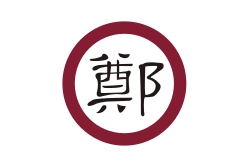 Flag of the Kingdom of Tungning (1661–1683)
Flag of the Kingdom of Tungning (1661–1683).svg.png) Flag of the Qing dynasty (1644–1912, on Taiwan 1683–1895)
Flag of the Qing dynasty (1644–1912, on Taiwan 1683–1895)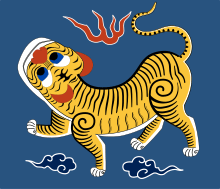 Flag of the Republic of Formosa (1895)
Flag of the Republic of Formosa (1895).svg.png) Flag of Taiwan under Japanese rule (1895–1945)
Flag of Taiwan under Japanese rule (1895–1945).svg.png) First national flag of Republic of China (1912–1928)
First national flag of Republic of China (1912–1928) Current flag of the Republic of China (1928–present, in Taiwan after 1945). Also used as a naval ensign of the ROC since 1912.
Current flag of the Republic of China (1928–present, in Taiwan after 1945). Also used as a naval ensign of the ROC since 1912. The "Blue Sky with a White Sun flag" was designed by Lu Haodong in 1895 and is still used as the naval jack of the Republic as well as the flag of the Kuomintang (KMT).
The "Blue Sky with a White Sun flag" was designed by Lu Haodong in 1895 and is still used as the naval jack of the Republic as well as the flag of the Kuomintang (KMT).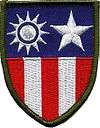 China Burma India Theater of World War II insignia as a uniform patch. This insignia is formed by the combination of both the flag of the Republic of China and the flag of the United States of America
China Burma India Theater of World War II insignia as a uniform patch. This insignia is formed by the combination of both the flag of the Republic of China and the flag of the United States of America
Gallery
- Chieh Shou Hall in the Presidential Office Building contains the flag and portrait of Sun Yat-sen which presidents face to take the oath of office.
 Pan-Blue supporters wave the ROC flag at a rally during the 2004 presidential election.
Pan-Blue supporters wave the ROC flag at a rally during the 2004 presidential election.- Flags of the ROC, PRC, and U.S. can be seen flying atop adjacent buildings in San Francisco Chinatown. Most benevolent associations in San Francisco, including the Chinese Six Companies, continue to fly the ROC flag due to their close relations with the KMT.
 ROC flag in the Taipei Economic and Cultural Office in Seattle.
ROC flag in the Taipei Economic and Cultural Office in Seattle..jpg) Flags of the United States and the ROC, 2016.
Flags of the United States and the ROC, 2016. Flags of the ROC and its diplomatic allies.
Flags of the ROC and its diplomatic allies.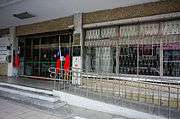 Four ROC flags in the Minsheng post office.
Four ROC flags in the Minsheng post office.- Series of the ROC flags.
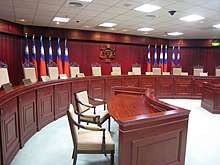 View of the ROC flags in the Judicial Yuan.
View of the ROC flags in the Judicial Yuan..jpg) Tsai Ing-wen with the ROC flags in the background.
Tsai Ing-wen with the ROC flags in the background.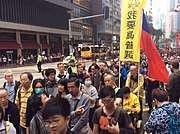 ROC flag in the 2019 Hong Kong anti-extradition bill protests.
ROC flag in the 2019 Hong Kong anti-extradition bill protests.
See also
- Blue Sky with a White Sun (the national emblem of the Republic of China)
- National Flag Anthem of the Republic of China
- Chinese Taipei Olympic flag
- Flag of the Qing Dynasty
- Flag of the People's Republic of China
- Flags of the Republic of China-Nanjing
- History of the Republic of China
- List of Chinese flags (listing both the PRC and ROC flags)
- List of Taiwanese flags (listing the ROC flags)
- Military of the Republic of China
- Politics of the Republic of China
- Proposed flags of Taiwan
References
- Official gazette of Ministry of the Navy of Republic of China, July 1912, page 344, pdf, National Central Library - Gazette Online
- Yu-liang, Tai (1954-10-23). 中國歷代陸軍旗幟 (in Chinese). Retrieved 2008-12-26.
- Yu-liang, Tai (1954-10-23). 中華民國國徽國旗法 (in Chinese). Retrieved 2008-12-26.
- "With flag ban, Cambodia adds to Taiwan's woes". 7 February 2017.
- "With flag ban, Cambodia adds to Taiwan's woes". 5 February 2017.
- Office of the President (2011). "National Flag". Republic of China (Taiwan). Retrieved 7 August 2011.
- 中華民國國徽國旗法 (in Chinese). 1954-10-23. Retrieved 2008-09-19.
- Yu-liang, Tai (2006-05-19). 黨旗國旗之製造及使用辦法 (in Chinese). Retrieved 2008-09-19.
- Yu-liang, Tai (2006-05-19). 國旗黨旗製用升降辦法 (in Chinese). Retrieved 2008-09-19.
- du Payrat, Armand (2000). Album des pavillons nationaux et des marques distinctive. France: Service Hydrographique et Océanographique de la Marine. pp. TA2.1.
- "Taiwanese spectators arrested". The Washington Post. Associated Press. 1996-09-01.
- singer upsets China with flag stunt - The Telegraph. 7 November 2013.
- Politi, Daniel (16 Jan 2016). "Did a 16-Year-Old Pop Star Help Pro-Independence Party Win Taiwan's Election?". Slate. Retrieved 20 January 2016.
- Zai, C.C.; Wang, Flor (16 January 2016). "MAC asks China to rein in private sector in wake of flag controversy". Focus Taiwan.
- (9 May 2018) Taiwanese flag on bull artwork painted over in Australia, BBC News. British Broadcasting Corporation. Retrieved 10 May 2018.
- Robinson, Paul; Terzon, Emilia (9 May 2018) Taiwan flag design painted over by council ahead of beef industry event, ABC News, Australian Broadcasting Corporation. Retrieved 10 May 2018.
- Everington, Keoni (9 May 2018) Australian council paints over children's Taiwan flags fearing beef with Beijing, Taiwan News. Retrieved 10 May 2018.
- Goodin, Dan (July 10, 2018). "iPhone crashing bug likely caused by code added to appease Chinese gov't". Ars Technica.
He said his fix addressed code Apple added likely to appease the Chinese government; this is the code that caused crashes on certain iDevices when users typed the word Taiwan or received messages containing a Taiwanese flag emoji.
- Wardle, Patrick (July 10, 2018). "A Remote iOS Bug". objective-see llc. Archived from the original on July 10, 2018.
- Greenberg, Andy (2018-07-10). "APPLE'S CHINA-FRIENDLY CENSORSHIP CAUSED AN IPHONE-CRASHING BUG". The Wired.
- Gurman, Mark. "Apple Pulls Taiwanese Flag Emoji From iPhones in Hong Kong". Bloomberg. Bloomberg. Retrieved 9 October 2019.
- Cheng, Kris. "Taiwan flag emoji disappears from latest Apple iPhone keyboard". Hong Kong Free Press. Retrieved 9 October 2019.
- TVBS News - 日本爆烏龍!錯把緬甸國旗當我國旗, May 23, 2010 (Traditional Chinese)
- NOW News - 沖繩車站介紹台灣,誤植緬甸國旗, May 23, 2010 (Traditional Chinese)
- "Myanmar's flag mistaken as Taiwan's in Okinawa". The China Post. 25 May 2010. Archived from the original on 2010-05-28. Retrieved 28 May 2010.
External links
| Wikimedia Commons has media related to Flags of the Republic of China. |
.svg.png)


